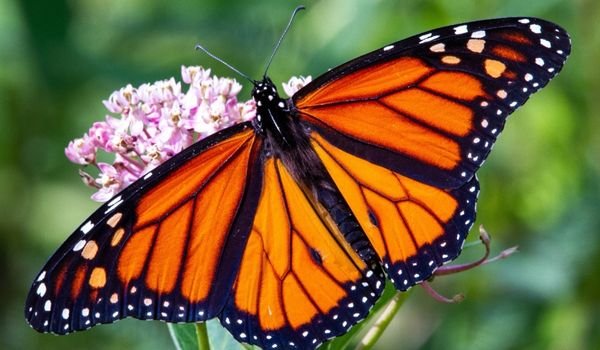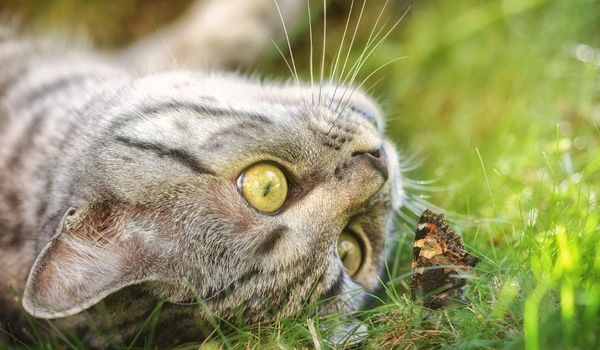Before cats became the center of our universe, they ruled the wild and hunted for their own meal several times a day. With domestication, the need is gone, but the instinct stays. Naturally, when you find your cat chasing a butterfly, you might wonder: can cats eat butterflies?
The thought of them endangering themselves with something as frivolous as a fascination with a flamboyant insect could be too much sometimes. So, we thought it would be nice to explore this little-discussed side of our cats and see if it poses any harm.
Let’s dive in.
Can Cats Eat Butterflies?
Yes, cats can eat butterflies as they have a decent percentage of nutrients in their body. But since they are too small, they could not play any notable difference in a cat’s diet. They primarily serve to satisfy their hunting instinct.
Although insect hunting is a harmless way to fulfill a critical feline need, it could sometimes be harmful if they consume toxic breeds like the Monarch or Tiger butterflies. In those cases, they may show signs of gastrointestinal trouble and should be back to normal in a matter of days. If they do not, seek an appointment with the vet.
Besides the possibility of toxicity, cats may also be exposed to pathogens if they consume an infected butterfly or caterpillar. A quick visit to the specialist in case of any signs of trouble would be an excellent way to deal with it.
Another reason you should watch your cat is the concern for biodiversity and the apparent threat its hunting poses to protected species, including some breeds of butterflies. Providing ample stimulation indoors could help you prevent these excursions effectively.
Read: Can Cats Eat Crickets?
Why Do Cats Eat Butterflies?
Cats are curious creatures and have a strong appreciation for bright and beautiful colors. In the eyes of the felines, butterflies are just bright little insects that fly so willingly close to them. And they happen to be playful too. They like to play and chase stuff thanks to their wild origins and natural aptitude for hunting that persists despite centuries of domestication.
So, you really cannot blame them for trying to chase and get hold of a captivating flying insect. Since they are carnivores, it makes all the sense to attempt to catch prey, however small it may be, and relish it like their ancestors once did in the wild.
Enjoy watching a cute kitten devour a lovely butterfly in this endearing video.
Do Butterflies Provide Any Nutrients to the Cats?
One study puts the protein content in the dry matter between 14 – 68 % at the larval and pupae stage. Another found caterpillars of certain breeds of butterflies contained 32 – 48 μg retinol (preformed vitamin A) and 6.8 – 8.28 μg retinol in every 100 grams of dry matter. In comparison, caterpillars of certain butterflies and moths possess 8.6 – 15.2 g of total fat per 100 grams of dry matter.
The nutrient content of these insects varies depending on the breed, stage of life, feeding source, season, and the region’s climate. In terms of life stages, caterpillars boast the highest energy reserves, while adults offer the most protein.
Are There Any Poisonous Butterflies?
Some of these, including the Monarch and the Plain Tiger, owe their toxicity to the plant material they feed on as larvae. The poisonous milkweed plant plays host to both breeds, which seem to have not just the tolerance for its bitter taste and poison but store it in their tissues as a defense mechanism.
Watch an interesting snippet of how a tiger butterfly manages to feed on the milkweed and use the toxins to its advantage.
The toxic cardenolides manage to sustain themselves as the caterpillars metamorphose into adult butterflies, giving them their characteristic bitter taste. But the warning for future predation does not end with a foul taste but also extends to the aggressive vomiting that ensues in the aftermath when a predator consumes it.
Other breeds, such as the Indian Fritillary, grow on the non-toxic wild viola and its cultivated variety pansy. Yet the butterfly hosts the poisonous cyanogenic glycosides, seemingly manufactured with the help of amino acids. These, too, lend an unpalatable taste to the butterfly, protecting it from predators.
Is it Alright for Cats to Hunt Butterflies? Concerns About Threats to Biodiversity
Backyard hunting is only a natural expression of the feline hunting drive and includes, besides the butterflies, other species of insects and mammals such as birds. However, the implications of meeting their hunting instincts can be huge in the context of biodiversity preservation.
It may be news to many owners, but free-roaming domestic felines have been scientifically proven to cause biodiversity loss. Pristine locations important in the context of ecological or biodiversity preservation are already subjected to stress with the expansion of urbanized localities. So, if you do live close to a forest, the chances of your cat preying on native fauna increase.
The stakes could be monumental if you live near a protected area or a conservatory housing species of concern. And while most of the time we assume these species to be avian or mammals, they may include invertebrates such as mollusks, spiders, beetles, and our dear butterflies. In this case, it would be responsible to introduce behavioral diversions or offer enough mental stimuli to deter their hunting detours outdoor.
Do Cats Eat Monarch Butterflies?
Monarch butterflies are poisonous and trigger a strong vomiting action in their predators. And it is not just the fully grown butterfly that is poisonous, but the caterpillar itself is also toxic to your cat. The good thing is these butterflies display a specific wing pattern and therefore are easy to identify when the predator is already familiar with it.

While birds have shown to learn their lesson pretty quickly and avoid the butterfly after a bad experience, we do not know if it happens with the cats too. On the bright side, the butterfly has a revolting taste; even if the feline does not remember it from a previous experience, it will immediately spit it out.
What to Do If Your Cat Eats a Poisonous Butterfly or Bug?
With the presence of over 750 breeds of butterflies in the United States alone, it is hard to discern if it is indeed a poisonous one that your cat just snacked on. Nor would it always be possible to tell what your tiny friend has been up to behind your back.
For one, such varieties have a bitter taste, so the kitty will immediately spit it out. Also, you can guess what transpired with the outcomes. Ingesting a toxic butterfly or caterpillar would induce gastrointestinal troubles such as vomiting and diarrhea.
Luckily, the poison is not strong enough to cause any serious harm beyond that, and the symptoms would go away within a day or two. But if the condition persists, it is time to see a vet.
But if you are aware of the presence of any toxic breeds in your vicinity or would prefer to practice caution, you could prevent your cat from doing so. Observations support the idea that cats that get sufficient stimulus at home may not find outdoor hunting charming enough. Try engaging them with sufficient play and interesting food puzzles to stimulate these instincts.
Final Words: Can Cats Eat Butterflies?
Although more of a hunting pursuit than a source of food, cats can eat butterflies. But a word of caution for the pet owners, as some of the butterflies or caterpillars can be poisonous or serve as intermediary hosts for pathogens. Poisonous butterflies may induce stomach issues that go away on their own.




